exploring rock formations
documentation
october
exploring rock formations
In my early inductions into the print studios I used a series of recent sketches and ideas that I had been working on over the summer. I had started to move on from working on a large body of work related to a residency I had done in Ireland in 2022 and had focused on a series of rocks that I had come across on beaches I had recently visited or walked on while doing the south-west coast path. These felt like a good subjects to explore in a range of techniques and get a feel for which resonated with me more.
I began with screenprint and chose to base the design on a drawing I had recently started of granite rocks near Lands End. These formations grouped into fascinating subjects seemed to have their own narrative shaped over millions of years and standing tall on cliff edges mediating that space between land and sea. They reminded me of photographs by Eileen Agar taken at Plumanc'h, Brittany in the 1940s which I enjoyed because of the space and respect afforded to them in her rock 'portraits'.
.jpg)
Brittany rocks, Eileen Agar, 1936
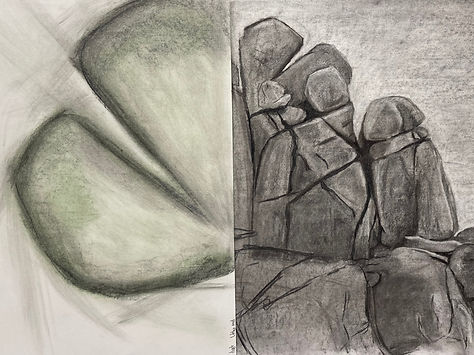
Rocks at Cape Cornwall, charcol and pastel
I had done screenprinting once before in a day workshop and though enjoyable found the results quite 'flat' and thought that the process itself left me feeling disconnected with the image-making. So with the specific subject I had chosen I was keen to try and explore what textures I could achieve. I made a sketch based on my drawing using litho crayons and then a seperate drawing of an outline. These were then photocopied to transfer onto the screens in the exposure unit. Lack of time meant I didn't explore creating tonal ranges with the digital image, but I was surprised how well the direct photocopy came out in the end. I was pleased to have got some texture from the method in the final piece, but I don't think I chose the best colours to show it off well! I think overall I felt the same about the relative flatness of the final work. I enjoyed experimenting with the background and using medium directly onto the screen when printing - interesting effects!


Screenprint experimenting with rock formations
stone lithography and feeling
I had done some work using lithography before the course started and it was good to bring this experience of working with stones. With my work being about connections to the land, to rocks, to coast, to the environment, being able to create art in a technique using rocks was an exciting prospect. The previous workshop I had done with Simon Burder at Oaks Editions also gave me an insight into the give and take process between the artist and the stone which I found fascinating. While this is true of working with all surfaces/matrix in printmaking, this felt to me the most sensitive and potentially elusive. Understanding the why of the Gum Arabic, the talc, the resin, the second etch, the dilution of the tusche, the damping of the surface etc, all becomes critical to what you can achieve. Even then a completely unexpected result can arrive. In some ways of course this is intensely frustrating, but I also started to feel like this relationship with the stone and how it works with you, is an intriguing collaborative process into a mutual journey of discovery. In a way the image is coaxed to life by way of a co-creation with the stone - how it responds to chemicals and what we do with it. Treating it respectfully, gently and encouraging it to say what it needs to. I also started having real concerns when I saw what seemed like ‘slapdash’ shortcuts in process and started having strange feelings of protection for the vulnerability of the stones. Maybe this is a feature of my own projections – I am sure the stone is fine! However, it was an interesting response.
The first stage of working with a stone - the grinding – is also fascinating to me. Using the carborundum grit and the levigator we are grinding away fine layers of ancient stone revealing a surface that hasn’t been exposed for millions of years. This is a significant connection for me in making artwork about geological time, its process and effect on rocks, the coastline and our place in it. The grinding of the stone, the patterns that appear in the surface, the sludge created and the sound it makes are all things I want to come back to.

Avon Beach rocks, pastel

Grinding litho stone
For the induction I made a close up drawing of some rocks that I had previously been working on. These were Portland limestone rocks had been placed on Avon Beach in Dorset as part of a coastal management programme and eroded overtime themselves into smooth and interesting shapes.
I was interested in the shapes, tones and texture in a close up drawing and this seemed to fit with the drawing materials available in lithography.
My first drawing came out very pale and a second attempt proved more successful. It seems that considerably more time will be required to understand how to achieve my intentions using the different drawing materials and collaboration of stone and chemical reaction.
I was pleased with the final piece with blue chine colle as a way of adding colour. And would like to do more with lithography to get to grips with the technique and see how it can fit with my work.


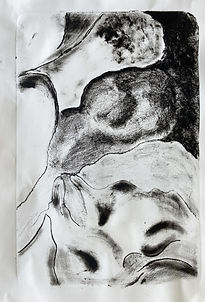
Litho stone drawings and prints from Avon rocks sketch
paper crumples into soft ground etching
I was sitting in A401 waiting for someone and had nothing with me to do. I saw on the table some items and decided to make something from what was there. I took a piece of charcoal and started drawing on tracing paper. For a long time I was very bored with my marks and had nothing to draw. Then I got annoyed and started crumpling the paper. This suddenly became interesting. What would happpen when I uncrumpled the paper? What marks would I see? How would crumpling it have changed it? I found the results fascinating and they had an uncanny relationship to the subject of my work - rocks. I drew over the charcol again layering up tones and trying to focus the marks on the creases specifically to acheive multiple tones. I kept re-crumpling and adding charcol. This started me off on the idea of crumple works.



Later I had the idea of crumpling that paper into a softground etching to get the texture from tissue paper into the plate itself. This did create an amazingly detailed print of the texture - you have to look very close up to see what's going on. I liked this aspect of it, but it still felt a bit - so what? I had been thinking about connecting to place and with my field trip to Kimmeridge coming up I printed the plate onto paper that had been painted with Kimmeridge Clay pigment. The result is perhaps too dark to be successful, but its starting to feel close to a work connecting to the environment and I will come back to this line of thought.



Crumple paper, soft ground etching on white paper and softground etching on paper painted with Kimmeridge clay pigment
considering space in a landscape
As well as exploring the feeling texture and shapes of rocks in my recent work I have been thinking a lot about space and how it is depicted. I have been reading about Munch's work recently and looking at how he creates space in his paintings and prints that I think allow for time for reflection. For example, 'The lonely ones' is very simplified, the rear view of the people allows you to see their view and consider what is going through their minds. But even in 'The beach landscape..' work with no people present the rocks become the subject that you wonder about - that you consider in their context. There is then an element of emptyness that allows this space for the viewer. Another element of interest in Munch's work is his ability to make his landscapes feel 'alive' there is something in the brushmarks and perhaps the apparent speed of the making that animates some of his works so they feel they are moving and have an 'aliveness' here. I approached my inductions for etching and relief with the intention of considering these themes.

The lonely ones, woodcut, Munch, 1899

The beach landscape at Askigardstrand, Munch, 1899
In the etching induction I worked from a photograph of a shoreline in Cornwall and explored using the line in a more animated form in my softground drawing. I enjoy the feeling of the softground and the fuzziness of the line quality.I decided to experiment using spitbite instead of stop/bite. I was pleased with the outcomes of the line quality, looking almost like a continuous line drawing with repetition which does goes some way I think to animating the image. The spitbite was darker than I expected and I know it is hard to control but I very much enjoy how tones bleed into each other and there are not hard lines/edges. I think the design itself it a bit too literal and it would be good to experiment with a more abstracted image to try to achieve a sense of place.




Shoreline etching experiments with softground and spitbite aquatint
With these small woodcuts I wanted to explore creating a sense of a more unexplained space with simple marks and shapes. I liked the idea of making the rocks and defining marks as negative rather than postive spaces so the colour filled the matrix and the viewer can move around and discover the space. I think in using a small block and filling the space I have lost some element of emptyness, but I like the ambiguity created with just one colour and white. The second version of the Shoreline print where I added a second colour makes the picture feel too much like a traditional landscape which I like less. I have done quite a lot of relief printing in the past and this short reconnection with it reminded me of why I like it - directly making the marks using tools and my hands and the fact that it forces you to work slowly so that time spent is a direct element of the work.

Kilve Bay woodcut


Shoreline rocks, woodcut
fossils in photolitho
In the induction to photolitho I combined drawn marks from a fossil with a background from a photo. Mainly this was done to understand the process and try out offset litho-registration. I found the process surprisingly quick and therefore could be quite a useful way to try out ideas. The image of a close up of a rock is one that I am still working out how to use. This comes back in part to the idea of a portrait of a rock that I discussed in Eileen Agars photos. It is something I will come back to in film I think as I want the viewer to spend time looking at and considering the rock itself without interruption - making it a study of the form and time of its creation.
Again I felt the disconnection of using a digital process. But did think of using a rock rubbing potentially as a background to combine processes. I realise its important to me to feel that that direct connection to a landscape - ie thorugh a rubbing - is present in the work.

Fossil study, photo lithography
november
chinese ink rubbings
While I had been completing all my inductions in print studios I had been missing the direct connection with working outside and the materiality of my subject. At this stage of the term I was still considering the subject of rocks being my main interest and while it was not quick and easy to go to the coast (though a field trip was planned for soon) I decided to make a study of some local rocks. I had noticed a circle of rocks in Lucas Gardens on my way to the bus stop and thought about making some frottage. I had done many rock rubbings before and was at the same time interested in other methods of making a rubbing. I came across videos online of Chinese ink rubbings of ancient stones and objects. This process is meticulous and time consuming but I am attracted to the approach which seems to honour the item being printed. This feels important to me and ties into how we treat litho stones and how we might consider a 'rock portrait'. I was pleased with the process of the rubbing though I was happier with the results of the small samples I did at home than the final rubbing from Lucas Gardens. I think this had more to do with the paper I used and the nature/type of rock - I prefered the edges and softness in the small studies - I think because there were bigger areas of flatness between the cracks.

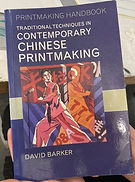
Rocks at Lucas Gardens



Rock rubbings

Rock rubbing drawing, Lucas Gardens
Taking rock rubbings at Lucas Gardens
field trip: kimmeridge bay, dorset
After my tutorial and group crit I knew I needed to focus my work on a specific location and make a field trip visit. To help me order my thoughts on location choice and critical factors I wanted to consider in my work I undertook some background research and reflections on my previous work. This information is shown in the additional research section. The process of doing this gave me a context of what to try and achieve in a field trip. Due to limited time I had to focus my ambitions but aimed to make some sound and film work, do onsite drawings, take photographs and walk in the area to gather research material.







Kimmeridge Bay, selection of field trip photos
I took a lot of photos at Kimmeridge and spent some time walking around and considering what it was I wanted to make of this environment and how I experience it. There is something for me about the combination of all that is contained in this small bay that feels very special. There is the rarity of having Kimmeridge rock exposed at a sea cliff edge, the variety of the rock formations, the fact that it is a site of scientific interest and has protected status, but also is the site of the longest operating onshore oil drill in the UK. The strangeness of the large scale wave platform exposed as the tide goes out each day, the variety and extent of the seaweed and huge range of fossils in the area. It is not a big swimming beach and doesn't have a huge toursit footfall, but people come for the fossils and the rockpools, they walk past on the coast path and they come to snorkel and explore those magical underwater environments. There is the slightly strange spectacle of stranded World War II tank defences and a leaning eroding Pillbox which is by parts sinking and moving down the beach.
While at the location I visited the Etches Collection - Museum of Jurassic Marine Life in Kimmeridge that houses 'the finest single collection of late Jurassic age fossils' (https://www.theetchescollection.org/). It was in discussion with Steve Etches, the founder of this museum, that I learned about the difference between the marine Kimmeridge strata rock formation, found at the coast, and the Kimmeridge rock used in stone lithography which is quarried in Germany. There is a gallery space at the museum and I am considering how I might work with this museum to show and situate my work on location over the course of or after my MA.
Below are pictures of sketches and rock rubbings made on location. Individual films and sound recordings are linked to the hosting site vimeo. I was pleased with the energy contained in the on-site drawing and experimented with many ways of making marks - it is clearly an image of the cliff, but I think contains some of the feel of the place within it. The rock rubbings were satisfying to do and using a lithography crayon worked well. I wonder if these have potential as backgrounds for other works or to use to draw into/monoprint with in the studio?
Fossils photographed at Etches Collection Museum, Kimmeridge, Dorset

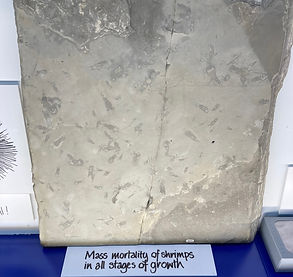



Kimmeridge Bay, plein air drawings and rock rubbings


film
I had taken my GoPro to make films underwater as I like the idea of capturing moments in and out of the water - with the land appearing and disappearing. I think this worked particularly well - especially in the films where we see the WW2 defences on the beach - it brings in a feeling of uncertainty and ambiguity about what we are seeing which I want to reflect in my work. The films of the rocks/cliffs are also succesful. I was interested in trying this close up filming after seeing a Mark Cousins film about the artist Wilhemena Barns-Graham that used this technique recently. I think Cousins' technique created an intimacy and interesting intensity which really connected to the environment being filmed (glaciers). In my film I think is also a level of ambiguity especially from the blurring of the image when it goes in and out of focus. I think the close up and the time spent with the subject helps the viewer to focus on what is being looked at; at the materiality and the geology and maybe to consider the how long ago in time this cliff was created. On some of the films there is a trickle of small rock fragments in the background - this is a constant in some sections as very loose stones fall from the cliff.
Kimmeridge Bay, selection of film clips
I liked the film of the nodding donkey oil well - its monotony and the view through the fencing. It seems so incongruous to come across this on a cliff top in a world heritage site and, other than the smell, it is not hugely dominating. Yet to see this extraction of oil drilling when we are faced with a climate emergency is also upsetting, frustrating and obviously short-sighted.
I had taken a sound recorder, hydrophone and contact microphone to record sounds on location. Unforunately the contact mic did not really work - I wanted to see if I could get any differences in sound from different materials/surfaces but this did not register. The hydrophone was more successful and I got sounds from entering/emerging from the water and the sound of it being moved along the underwater rocks.
The overall experience of the field trip was very positive (apart from the cold!). I think I got useful material in a short trip and it helped to re-establish my connection to that location. Being and working in the place alone also seems to be a really important part of my practice. When I walk the coast path with friends I find it difficult to find that space to work, to consider, to respond to a place in the same way.
When I got home I started to think more about the trip I had made - the planning and excitement of arriving in a place and then almost a sadness to be leaving. Maybe by not living at the coast and repeating these pilgramages I am re-creating some of that childhood excitement of going on holidays, of moving from a place of rules and way of life in the city to a place of openness to something different, to uncertainty where I can be someone else? I don't know, but there is a feeling of wanting to go / wanting to stay and that push-pull just like the tide coming in and going out which seems to resonate. Maybe knowing that my trip is short adds to the intensity of the experience and the drama of the 'flying field trip'.
using film stills: paintings and monoprint
On my return from the coast I spent time looking at the films and wondering what next steps to make. The first thing I tried was to print out film stills that appealed to me and make a series of paintings from them. I don't know if these will become something else but they helped me to identify which parts of the films I liked best - the underwater/emergence from the water, the shapes of the wave cut platform and the empty spaces in between the rocks on the beach.





I also used a film still from a close up from a cliff to work from in the monoprinting workshop. I was keen to explore a way of creating a sense of the place in the work without being too literal in depicting a subject. I felt this worked well with a film still close up as it is abracted to a large extent, but still has colours and textures of the place, see pictures below.
I enjoyed very much the painterly aspect of monoprinting and the immediacy of the image. I think this is something I will return to to try out ideas. The ability to work up layers is particularly attractive - it fits with the subect matter of layering of rocks and also with end results of work that I like - which has evidence of many layers - hiding and revealing whats underneath.

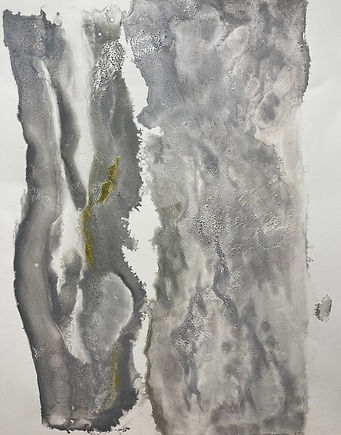

Kimmeridge Bay, watercolour paintings from film stills
Monoprints based on source photo - far right
developing crumple textures
After my field trip and having seen the rocks and cliffs close up again I decided to go back to my crumple papers. I wanted to explore this idea of creating something sculptural that had many qualities of the rocks, but obviously was maleable and became an art object in itself. By this time I had also seen Emma McNally's work at the Drawing Room and was inspired by the scale and level of experimentation in her work. I was storing the crumpled paper in balls so I could transport them easily and I realised that the opening out of the ball of paper - the sound and anticipation of what might be, was an exciting part of the process for me. I showed some balls of crumpled paper at my group crit asking people to open them and say something about the experience - many agreed and were fascinated by the simplicity of the idea and the effect.
I photographed them outside and enjoyed the different lighting effects - especially from natural sunlight. I made a film clip outside later in reponse to this.



Following these experiments I went back to the proposition for my work that it has to feel that connection to place and began by painting paper with pigment from Kimmeridge Bay clay before crumpling it. I used a Japanese paper that already had a natural colour to it which gave a different effect but this is worth persuing with different papers.
Crumple paper studies and paper with Kimmeridge pigment (far right)
working with stones
I wanted to go back to my earlier idea of working with the materiality of the lithography stone itself. The connection of the source of these stones to my field trip site of Kimmeridge was quite profound and I wanted to see what would come of using the actual 'matter' of the stones themselves. I spent a morning grinding stones and also had collected some of the ground 'clay' from the surface of other stones and from Oaks Editions studio when I had worked there. As well as using this material to make marks/prints I also wanted to try and take an impression of the shapes created by the levigator which seemed too good not to try and capture.




It was quite diffciult to get the clay material to adhere to the paper rather than the stone - I tried dampening the paper which helped a bit and I only got a portion of the material coming off the stone onto the paper but nevertheless I find the results very satisfying. As it dries the material becomes like dust and the delicacy of the image and the fragility of the dust on the thin paper is a pleasing contrast to the mechanics of stone grinding and the solidity of the stone itself.
I also used some of the litho 'clay' as a pigment and painted some small sections of muslin onto paper. I have used this technique before as a way of transfering pigment to paper. The muslin becomes stained with the pigment but once it has dried and is peeled away from the paper it also leaves behind the trace of the process. This is captured in the photos below and a short film that I made with the help of my colleague Chelsea.
Making prints direct from litho stone using carborundum grit and stone

Making prints direct from litho stone using carborundum grit and stone
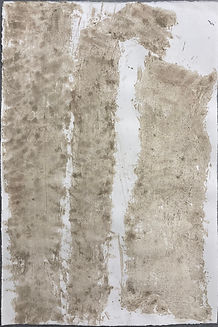
I liked the results of this experimenting and feel like there is definitely something here worth exploring. It might be worth using this more as a pigment or using the trace prints as a background for further work or to project a film onto. I think its important to note that while my intention is to try and get to something of the stone itself I realise that there is a lot of carborundum grit in this 'clay mixture' and I am not sure how this affects how I feel about the results. Obviously there are different stones of different tones of grey/white and it might be interesting and another whole project to explore this!
december
mediating the image: crumple papers
I decided that it would be useful to try out the crumple paper as a source document for mediating my image in the December print workshop - partly because it would be a good challenge to put something that is so tactile and sculptural through digital processing. I used the Japnese Kozo paper with Kimmeridge Bay pigment on it as a starting point and photocopied the crumple, made an image transfer and got a extra large print from Lars. On this large print I then collaged some further photocopies and tried crumpling one half of the large paper sheet.



I liked the results of the photocopying and image transfer more than I thought I would. The photocopy of the original crumple paper is particularly interesting. It seems to give it a cinematic and almost renaissance feel because of the lighting and softness from the copying. This works against the sharpness of the original crumples but in a way that I think is quite appealing. The third picture shows the transfer image before I removed the plastic backing. The image itself wasn't as clean as this but in some ways I like this more. Its made me think of trying to integrate a photo image alongside or within a very organic natural surface - I think the contrast works and its an interesting commentary on digital and traditional approaches to work.
Below is the large-scale piece that I transformed with collage and crumpling. I dont think this is very successful, but I like the idea of having two contrasting pieces side by side and will try this in another way. The final picture shows a display of work made during this process.
Crumple paper with Kimmeridge pigment, photocopy and image transfer


Large crumple paper photocopy with collage and additional crumpling, studio wall display
developing spitbite and hand shaken aquatint
I had been keen to get back to try out more spitbite etching after my earlier interest in it. I decided to first do some experimenting with an old image - an abstraction of a shaped rock - and then use the monoprint that I made from a film still from my field trip as a starting point.
Brian showed us how to do the hand shaken aquatint on top of a box aquatint and then also gave us a number of larger aquatint rocks that we could put on the plate surface. The first rock print was done in two stages. First I put down a box aquatint and then drew the design using spitbite. I then printed the image to check it. The I applied a second box aquatint and did a flash etch to ensure there was a light grey across the whole plate, before adding large aquatint rocks in certain places. The effect is almost watery rather than looking like 'rocks' but I think it adds a really interesting quality to the work. It breaks up the surface in an abstract and more random way adding texture but also having an element of uncertainty - what is it really? I enjoy this not knowing and providing space for the viewer to consider.



Abstracted rock drawing and spitbite with handshaken aquatint prints
My second image came from the monoprint workshop using a film still of rocks as a starting point. The work became more abstract as I worked from that and I was more concerned with the mark making and exploring ways of applying spitbite to make different marks and tones. I was pleased with the results and the impact of the rock aquatint. This feels like a first layer and I will continue to work on it next term.
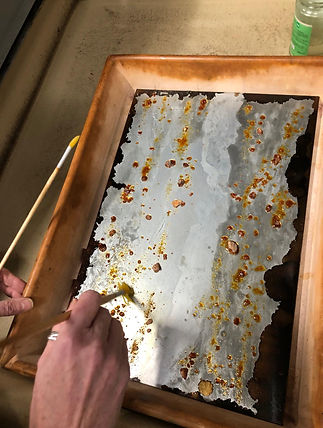.jpg)


Rock aquatint and spitbite experiments
pop-up show
For the pop-up show I wanted to project a film and I had been looking back at my field trip films to work out what to choose. I started out thinking of taking two films - one of the underwater/emerging to the surface and the one of the oil drilling donkey - and have them running side by side. I wanted to juxtapose the two extremes of the one environment at the same time. However, I also was really interested in incorporating the film of the crumple paper as it added another dimension in terms of a 'created landscape' to the real landscape in the other films. I decided then to run the three films on a loop and find a way to project that onto a wall. I changed the film of the oil donkey from colour to black and white as I felt it was too jarring.
I had also been thinking about how to incorporate an element of the crumpled paper into the curation and decided to try out projecting it onto a sheet of white crumpled paper to see how it looked. I really enjoyed the distortion of the film and feel like it added an element of depth. It also connected the digital film with the physicality of paper in an interesting way.
How to incorporate sound was also an interesting challenge. I hadn't go a lot of sound from the field trip and I mixed what I thought most succesful to the underwater/emergence film as it fitted with being created underwater. I decided to record the sound of crumpling paper to go with the same film which I thought worked well in evoking a crushing ambiguous sound which was appropriate. I had not thought a lot about how sound and film worked together - other than recording the actual sounds in the landscape so I spent some time researching this and in particular looked up a previous tutor/sound artist Rebecca Glover. Some details of this research and relevance to my practice are noted here. Luckily, my fellow students who exhibited in the same room were happy to have my sound playing.
I also thought I might show a print alongside the film I liked the idea of having the digital next to a physical print. I tried this out (see pic below) and it was clear that the lighting would not be sufficient to see the print properly and it did seem to detract from the film itself. I did offer the print as an option for the show seperately but unfortunately there was not a good spot for it in the curation. I was happy enough with the film projection in any case.



Installation experiments (x2) and final installation shot
The curation of the show was an interesting experience. It was very difficult to attempt to do a large group curation of everyones work, but I did enjoy making suggestions and looking at all of the groups work together. A particular comment that Jo made connected with me when she said that the curation is an opportunity to enhance the work, to consider what can be brought out in the work. This was very illuminating and I could see in the final curation where different students work had been hung together or was located in several places around the room how this had worked. Being in a more dimly lit room was perfect for my piece and I thought it worked well the other work in the room. I do think it would have benefited from being in a completely dark room in ideal conditions to really see the film content properly.
It was difficult to take good photos of the film due to the lighting and the film shown below is clearly not the same as in the show because it doesn't have the benefit of the crumpled paper for projection.



Installation shots showing the three different film clips
Final film for pop-up show